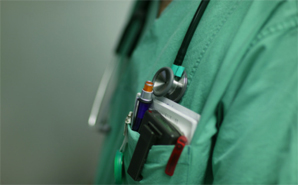

In this edition of “He Said/She Said,” Dr. Brady Pregerson and Nurse Rebekah Child talk about The Perils of Beauty in healthcare fashion and function.
Nurse Rebekah: So this month’s edition of “He Said/She Said” is all about fashion…kind of.
I remember reading an article once that discussed the length and weight of doctors’ white coats. The longer and lighter your coat was (fewer books in the pockets = lighter coat), the higher up on the physician food chain you were. Many police officers sustain workers-comp injuries from their gun belts; the belts are so heavy, it throws their backs out.
I wonder if the same couldn’t be argued for medical students and first-year residents. Unfortunately, they aren’t allowed to take sick days to figure out if all the reference texts weighing down their coats are the cause of their sciatica. I still can’t figure out why they haven’t put all those books on a PDA application by now [editor’s note: there are some very helpful iPhone apps]. Maybe the books are just old-school security blankets. As for the attending’s empty pockets, some hypothesize that their wizened experience means they have all these facts memorized by now; others would say they have mastered the art of delegation.
Dr. Brady: I’m no fashion prince—just ask my wife—but I do try to don acceptable, if not respectable, attire. I gave up scrub pants a long time ago so I could wear something with more pockets.
Now I mostly use scrub pants for rock climbing at the indoor gym; they’re perfect because they’re light and cover my knees, which otherwise sometimes get scraped. I used to wear a scrub top, but gave that up when my director kept noticing that I was “untucked.” Let me tell you, when you’re 6’4” it’s hard to keep your shirt tucked in at work; shirts just aren’t long enough.
I still haven’t taken to wearing a tie at work. There’s a fomite that never gets washed. Plus, I don’t want a homicidal schizophrenic to be able to grab onto a slipknot around my neck.
Although pocket books and other medical references might not be considered part of a doctor’s “fashion statement” by many, Rebekah has a good point. The lack of additional white-coat real estate is actually one of the first things you notice in someone whose pockets are brimming over. Many doctors (and nurses) opt for PDAs or iPhones to store information they want on hand, but I’m still a fan of some of the better pocket texts. All you need are one or two, and paper is still lighter, cheaper and less breakable than the alternative. The series from ERPocketBooks.com is one of my favorites.
—————————
Think about it: Is your work attire streamlined and practical? Lots of pockets are great, but are you carrying around anything you don’t need? In Part II of “The Perils of Beauty,” Nurse Rebekah and Dr. Brady talk about what else might be hitching a ride on your clothes, and in Part III, they discuss what happens when germs end up in your hair, on your hands, and all over your face..
When we discuss students, we always mention their qualities. Those qualities show what they are…
If you or someone you know is juggling mental health issues alongside substance abuse, understanding…
For the last couple of weeks, the Israel-Hamas conflict has taken over the news cycle.…
Our eyes are invaluable, serving as our windows to the world. The ability to see…
Undoubtedly, one of the most demanding and challenging professions is nursing. Nurses work long hours in…
Echocardiography, or echo for short, is a key diagnostic test used by cardiologists to assess…